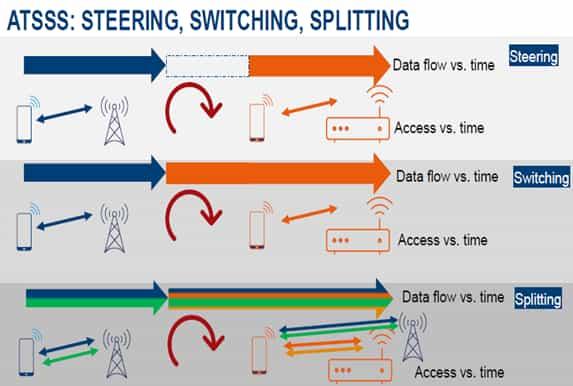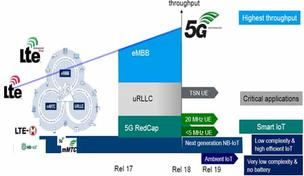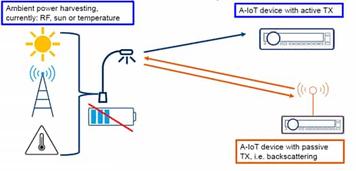ATSSS in 5G: Features, Benefits & Limitations
Advertisement
What is ATSSS (Access Traffic Steering, Switching, and Splitting)?
ATSSS is an advanced 5G feature that allows a single device, like a smartphone, to connect to and use both a cellular network (a 3GPP access, like 5G) and a Wi-Fi network (a non-3GPP access) simultaneously.
ATSSS achieves its goal through three primary mechanisms.
-
Steering: This function involves intelligently moving a specific data flow from one network access to another. For example, if you start a video call on 5G and then walk into your home where the Wi-Fi is stronger, ATSSS can seamlessly “steer” the call’s data traffic over to the Wi-Fi network without dropping the connection. The data flow is active on only one path at a time.
-
Switching: This is a more definitive action where the device completely moves its connection from one access to another. This is different from steering a single flow; it represents a full handover of the session. For instance, if the Wi-Fi network you are on becomes too congested and slow, the device can switch the entire data session over to the more reliable 5G network.
-
Splitting: This is the most powerful function of ATSSS. It allows a single data flow to be split across both the cellular and Wi-Fi networks at the same time. By doing this, the device can aggregate the bandwidth of both connections, leading to significantly higher download or upload speeds. For example, when downloading a large file, parts of the file could arrive via 5G while other parts arrive simultaneously via Wi-Fi.
A device with ATSSS doesn’t just randomly choose a network. It follows a set of intelligent rules or policies, known as Steering Modes, which are defined by the network operator. The examples of some of these modes are active-standby, load-balance, priority-based and best access.
 Image Courtesy : Rohde & Schwarz
Image Courtesy : Rohde & Schwarz
MPTCP & MPQUIC Multipath Protocols
ATSSS is not a new radio technology itself, but rather a feature that relies on advanced, multipath aware transport protocols. The two key protocols are MPTCP (Multipath TCP) and MPQUIC (Multipath QUIC). These protocols are designed to manage a single communication session that is split across multiple network interfaces (IP addresses). They handle the complex task of splitting the data, sending it over different paths, and reassembling it correctly at the destination, making the entire process invisible to the application and the user.
Benefits of ATSSS
Following are some of the advantages of ATSSS.
- Enhanced Connection Reliability and Resilience: This is perhaps the most critical benefit for the user. By actively using two different network technologies (e.g., 5G and Wi-Fi), a device can protect itself against common connection problems. If user walks out of Wi-Fi range or the Wi-Fi network becomes congested and slow, ATSSS can instantly and seamlessly switch the data session to the more stable 5G network.
- Increased Performance and Throughput : Allows a device to aggregate the bandwidth of both the cellular and Wi-Fi connections. For data-intensive tasks like downloading large files, watching 4K/8K video, or engaging in cloud gaming, the device can pull data from both sources simultaneously.
- Seamless and Uninterrupted User Experience: ATSSS automates the complex process of network selection and management. The device handles all the monitoring and decision making in the background, ensuring the application (e.g., a voice call, a video stream) continues to work flawlessly, regardless of which underlying network technology is being used at any given moment.
- Efficient Network and Resource Management: ATSSS provides significant benefits to network operators. Using the “Priority-based” steering mode, operators can create intelligent policies to offload non-essential or heavy traffic from their licensed (and more expensive) cellular spectrum onto Wi-Fi networks whenever possible. This frees up valuable 5G capacity for high-priority services, reduces congestion on the cellular network, and can help users conserve their mobile data allowances.
Challenges of ATSSS
Following are some of the limitations of ATSSS.
- To make intelligent decisions, the device must constantly monitor the performance of both its cellular and Wi-Fi connections. This is power consuming which is major drawback for mobile devices. Moreover, use of multipath protocols add to processing overhead on the device.
- ATSSS is not a simple “on/off” feature. It relies on a sophisticated policy framework managed by the network operator. This requires a robust and complex Policy Control Function (PCF) in the 5G core network, adding a layer of operational complexity and cost for the carrier.
- The logic that decides when to steer, switch, or split traffic must be very intelligent. If logic is not managed correctly, it may lead to packet loss, introduction of latency and out of order packet delivery.
- ATSSS effectively creates a bridge between two different networks: the highly secure, operator managed 3GPP cellular network and a potentially untrusted non-3GPP network (like a public Wi-Fi hotspot). Ensuring that data remains encrypted and secure as it traverses these different trust domains is a critical challenge. The connection must be properly secured to prevent data interception or man-in-the-middle attacks.
Summary: ATSSS represents a powerful advancement in the convergence of multiple access networks which enables devices to intelligently steer, switch or split traffic across 3GPP and non-3GPP links (e.g. cellular plus Wi-Fi) for improved throughput, resilience and user experience
Advertisement
 RF
RF




